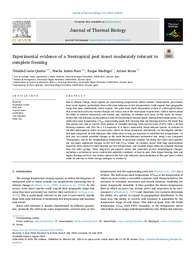Resumen :
Due to climate change, many regions are experiencing progressively milder winters. Consequently, pest insects from warm regions, particularly those with some tolerance to low temperatures, could expand their geographic range into these traditionally colder regions. The palm borer moth (Paysandisia archon) is a Neotropical insect that in recent decades has reached Europe and Asia as one of the worst pests of palm trees. Little is known about its ability to tolerate moderately cold winters and, therefore, to colonize new areas. In this work, we characterized the cold tolerance of Paysandisia archon by measuring its thermal limits: median lethal-temperature, LT50, chill-coma onset temperature, CTmin, supercooling point, SCP, freezing time and freezing survival. We found that this species was able to survive short periods of complete freezing, with survival rates of 87% after a 30-min freezing exposure, and 33% for a 1 h-exposure. It is then a moderately freeze-tolerant species, in contrast to all other lepidopterans native to warm areas, which are freeze-intolerant. Additionally, we investigated whether this insect improved its cold tolerance after either short or long pre-exposure to sub-lethal low temperatures. To that end, we studied potential changes in the main thermo-tolerance parameters and, using X-ray Computed Tomography, also in the morphological components of pretreated animals. We found that short pre-exposures did not imply significant changes in the SCP and CTmin values. In contrast, larvae with long pretreatments improved their survival to both freezing and low temperatures, and required longer times for complete freezing than the other groups. These long-term pre-exposed larvae also presented several morphological changes, including a reduction in water content that probably explained, at least in part, their longer freezing time and higher freezing survival. Our results represent the first cold tolerance characterization of this pest insect, which could be relevant to better design strategies to combat it.
|
 La licencia se describe como: Atribución-NonComercial-NoDerivada 4.0 Internacional.
La licencia se describe como: Atribución-NonComercial-NoDerivada 4.0 Internacional.
.png)
